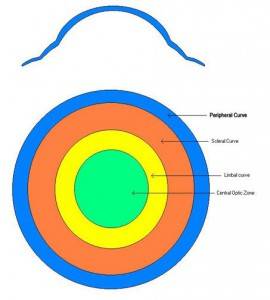 They are about the same size as most soft contact lenses. They completely cover the cornea (the clear dome of tissue that covers the colored part of the eye) and sit on the white part of the eye rather than on the cornea. Corneal lenses sit on the cornea and do not extend past the junction between the cornea and the sclera. Scleral lenses are supported exclusively by the sclera, and completely vault (don’t touch) the cornea. These lenses extend don’t dislocate.
They are about the same size as most soft contact lenses. They completely cover the cornea (the clear dome of tissue that covers the colored part of the eye) and sit on the white part of the eye rather than on the cornea. Corneal lenses sit on the cornea and do not extend past the junction between the cornea and the sclera. Scleral lenses are supported exclusively by the sclera, and completely vault (don’t touch) the cornea. These lenses extend don’t dislocate.
Soft lenses simply sit on the eye and therefore take the shape of the cornea. Distortions in the cornea such as astigmatism or imperfections after LASIK, PRK, or other refractive conditions, therefore come through, and sometimes don’t achieve the clarity that most people are looking for. Soft lenses often dry out and therefore cause blurred vision, feelings of dryness and irritation, especially when people work on computers or read extensively.
What are the benefits and advantages of Scleral lenses?
- Better Comfort. Since scleral lenses rest on the white part of the eye (sclera and conjunctiva) they are usually more comfortable than lenses than lenses that rest on the cornea.
- Clear vision for people that have become intolerant to soft lenses. These lenses don’t dry out as the progresses, a common complaint of people who wear soft lenses, especially if they work on computer for many hours.
- Individuals with a dry or a very wet eye benefit from scleral lenses because they have a reservoir of fluid behind the lens. This then protects the cornea, and may even allow it to heal in cases where the cornea was damaged.
- These lenses extend under the upper and lower lids are rarely dislocate. They are approximately the same size as most soft contact lenses.
- People who have had LASIK or other refractive surgeries that have been less-than successful or they now find it difficult to read without wearing reading glasses.
- Keratoconus and Pellucid Marginal Degeneration: these are diseases of the cornea where there is distortion. The scleral lenses create a new, clear, optical surface and enable people to regain clear vision.
- Problems after a Corneal graft or corneal transplant: when someone has had a corneal transplant, there is often a considerable amount of astigmatism and distortion. The Sclerla lens enables the individual to see once again.

Who Could Benefit From Scleral Lenses?
- Patients with irregular corneas
- Patients with conditions that affect the tear film
- Patients with refractive conditions (nearsightedness, farsightedness, or astigmatism) who are unable to wear other forms of correction could benefit from scleral lenses.
- Conditions such as keratoconus and pellucid marginal corneal degeneration cause irregularity in the surface of the eye.
- Surgery (keratoplasty, refractive surgery) can also lead to corneal irregularity.
If the cornea is not smooth, vision is not easily corrected with eyeglasses or most soft contact lenses. Scleral lenses cover the irregularity and allow for clearer vision by providing a smooth front surface through which light can enter the eye.
They are ideal for patients that have a dry or a very wet eye because they have a reservoir of fluid behind the lens. This then protects the cornea, and may even allow it to heal in cases where the cornea was damaged.
Some patients have disorders that affect the quality or quantity of tears that help to keep the eye’s surface smooth and healthy.
Dry eye syndrome, graft vs. host disease, Sjogren’s syndrome, Stevens Johnson syndrome, are examples of such conditions.
Some inflammatory conditions cause serious damage to the front surface of the eye. Patients who cannot close their lids completely (lagopthalmos) due to Bells Palsey for example, may also experience problems with the health of the surface of the eye.
Patients who are not able to wear other contact lenses, may find larger-diameter lenses more comfortable than other lens designs.

Are Scleral Lenses New?
Scleral lenses were actually the first contact lenses described in medical literature in the late 1800’s and were invented by Leonardo da Vinci.
However, due to manufacturing challenges and because of the lack of oxygen transmission through early lenses, scleral lenses were not popular until now.
During the 1900’s, first corneal hard lenses, and then corneal gas permeable lenses and soft contact lenses became increasingly popular.
Corneal rigid gas permeable lenses and hydrogel lenses may not be able to solve some of the problems caused by corneal irregularity and eye surface disease.
In the 1980’s, scleral lenses began to be used to treat conditions that could not be otherwise be treated with other contact lens designs.
The material these lenses are made from allows more oxygen to the cornea than do soft or hard lenses. Better designs and manufacturing processes have made it easier to fit and prescribe scleral lenses.
